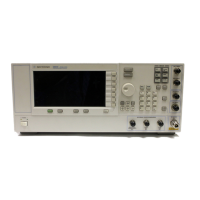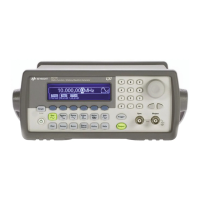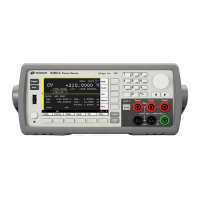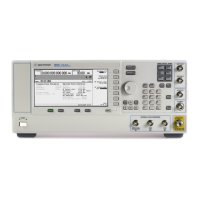E8257D/67D, E8663D PSG Signal Generators Service Guide 163
Troubleshooting
RF Path Description (Frequency Generation, Level Control, and Modulation)
— FM rates >100 kHz are routed from the A6 Frac–N to the A9 YIG Driver and
applied to the FM coil in the YIG Oscillator.
— For phase modulation, the FM drive signal is routed through an LCR circuit
Other than the LCR circuit, ΦM signals are routed the same as FM signals.
Pulse (Options UNU and UNW)
Pulse modulation signals from the A11 Pulse/Analog Modulation Generator
depends on model and option can be routed directly to the A8 Output and the
A30 Modulation Filter or A12 Pulse Modulation (UNW) pulse diodes. Pulse
diodes must be biased on to pass RF signals. Circuitry on the A8 Output, A30
Modulation Filter, A36 Quadraplier, and A37 44 GHz Upconverter keep the
pulse diodes turned on in instruments that do not have modulation capability.
Because ALC bandwidth is limited, the ALC circuit can only level pulse widths
> 1 microsecond. To level pulse widths < 1 microsecond, use search mode.
Search mode calibration sequencing is as follows:
1. Modulation is turned off.
2. The ALC feedback loop is closed and the RF power leveled.
3. The ALC feedback loop is opened and the integrated output voltage used
to drive the ALC diodes is maintained at the level determined during
closed loop operation (step 2).
Changes in power level, frequency, or pulse settings cause the signal
generator to repeat the search mode leveling procedure and determine a new
ALC diode drive level. Because drift in that leveling circuit can occur over time
in open–loop operation, it is not recommended to stay in search mode for
extended periods of time without closing the loop and refreshing the ALC diode
drive voltage.
Digital Modulation
Digital modulation is produced using portions of the following major
assemblies:
—A8 Output
— A13 I/Q Multiplexer
— A14 Baseband Generator (Option 601/602)
— A35 I/Q Modulator
Together, these assemblies generate and route the baseband signals to the I/Q
modulators located on the A8 Output and the A35 I/Q Modulator. The A8
Output modulates carrier signals form 250 kHz to 3.2 GHz, while the
A35 I/Q Modulator modulates carrier signals form 3.2 to 20 GHz. The
A14 Baseband Generator (Option 601/602) comprises data generation, burst
control, and symbol building circuitry. The output section of the A14 Baseband
Generator consists of two 16–bit DACs: one for the I signal and one for the Q
signal. The data produced from these I/Q signals is converted to analog,

